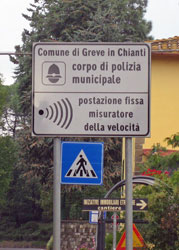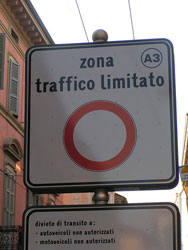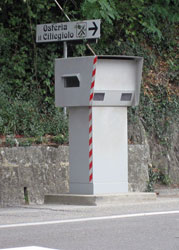Beware of limited-traffic zones
In September ’08 my wife and I and our friends Ralph and Lynn went to Italy, where we drove all over the Tuscany area in a rental car from Auto Europe. About nine months after our return, in a letter dated June 23, 2009, I was notified of two traffic citations by the Florence police, one for a traffic violation on Sept. 17, 2008, and one for Sept. 22. Each fine was for €103 (near $155). On July 31 I received an almost identical one from the Sienna police for a violation on Sept. 19.
Each citation states that our vehicle had been in a limited/restricted traffic area “without authorization.” The area in which I drove in Florence was specified “E5.” (How’s that for narrowing down the location?) The area in Sienna was “V Fontanella Varco 3.”
The notices I got are not actually from the police but from European Municipality Outsourcing (EMO), “a partition of Nivi Credit, Ltd.” (www.emo.nivi.it). Each was titled “Notice of payment before the notification” — I was being given the opportunity to pay the fines before the official tickets were sent. I wondered why I would want to do this, but if I appealed the citations and lost, the fines would be doubled. It was also made clear that my AmEx card could be charged without my authority.
Next I received, from the EMO office in Florence and posted Oct. 7, the “official” ticket for the Sienna infraction followed by the two official tickets, dated Oct. 30, for the Florence infractions; these each were titled “Violation of the Highway Code.”
On Nov. 13 Ralph called the number for EMO, in Italy, that was listed on the citations and was informed by “Denise” that I had been driving in a restricted historical area. At the time, of course, I was not aware of this.
However, Denise acknowledged that more than 360 days had passed from the date they had been notified by the car rental company, which, she said, was in the first week of October 2008. (I don’t know why they waited so long before notifying me.) In any case, she stated that the time limit had been exceeded and agreed to dismiss the fines.
On Dec. 1, I received an e-mail from Denise stating that my two tickets in Florence had been canceled by the police. She added, “Your position is settled.” I am hopeful that my Sienna ticket will be canceled as well.
JOHN THORSON
Darien, IL
Both the Seymours and the Thorsons strayed into a “Zona a Traffico Limitato,” or ZTL, a few times. Many cities, not only in Italy, now have areas where traffic is strictly controlled or limited. Travelers unfamiliar with these areas may trespass unwittingly and be issued a citation by an automatic camera. Drivers need to be alert for signs posted at intersections and cameras positioned along the streets.
ITN was unable to locate a road atlas or definitive maps of all the restricted areas in Italy, but several websites run by city governments do offer small maps (often difficult to find and not in English). Venice has a special ZTL Bus that runs within ZTL zones; a map showing locations of a few cameras there can be found at the bus company’s website (www.asmvenezia.it/scaricabili/mappa_ztl_a4_ita.jpg).
Upon picking up a rental car, travelers should ask the rental car company for a map or description of restricted areas.
ITN readers, if you know of other cities with limited-traffic zones or of specific ZTL locations or if you can tell others where to find a ZTL map or what a particular area’s traffic warning signs look like, please write to Limited Traffic Zones, c/o ITN, 2116 28th St., Sacramento, CA 95818, or e-mail editor@intltravelnews.com, and ITN will share the information.



